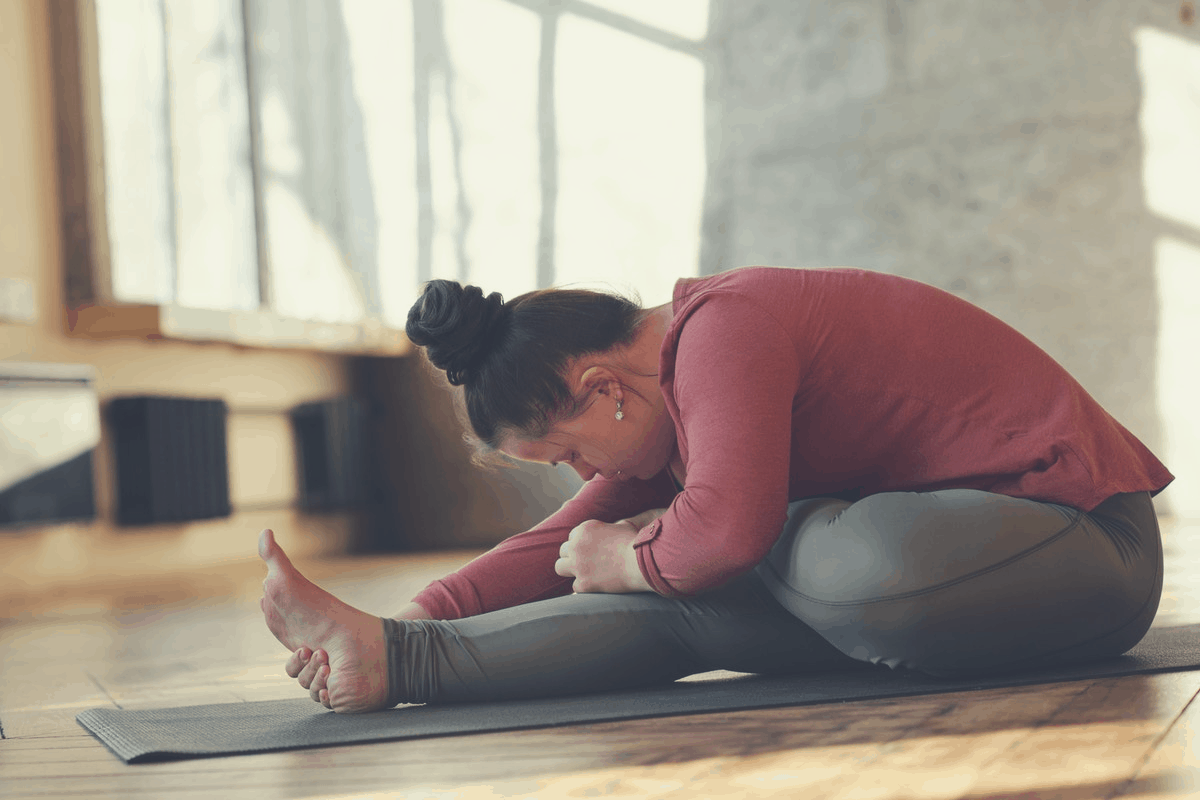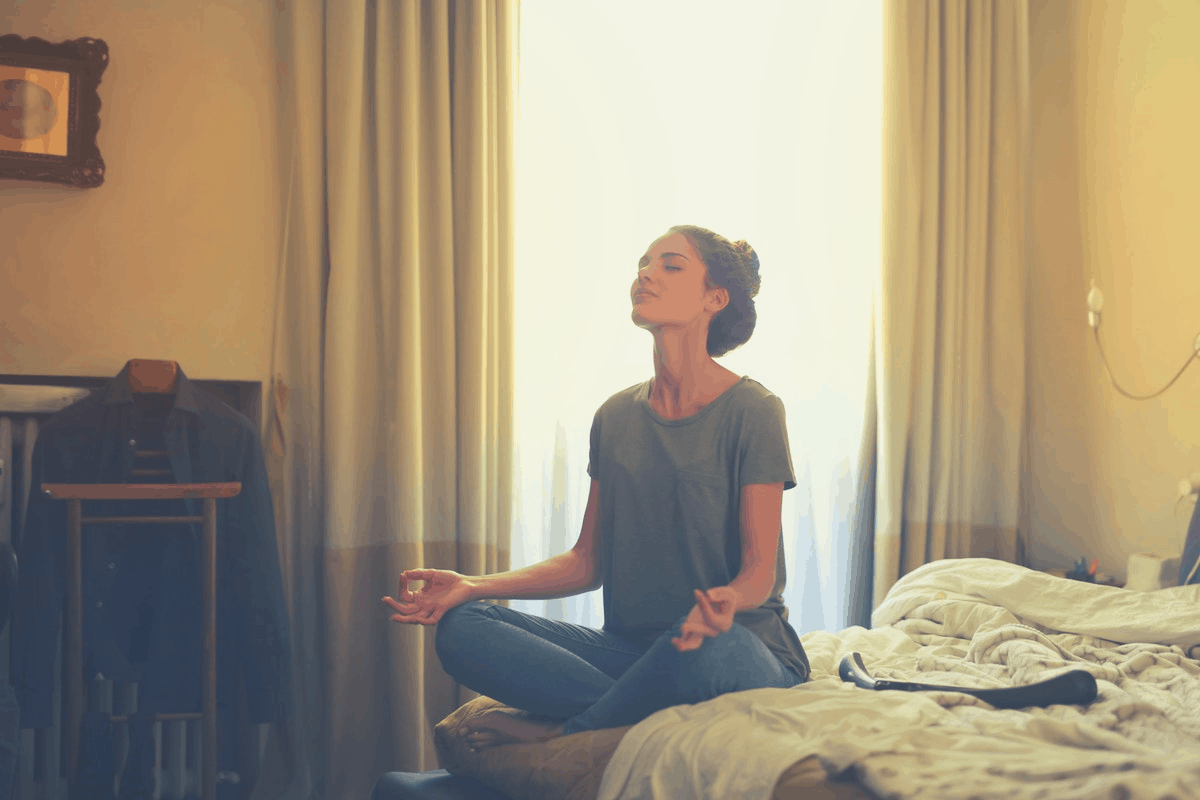Do you toss and turn for several hours before finally falling asleep? You’re not alone. Millions from all walks of life report similar problems due to one reason or another.
The situation can get so bad that extreme anxiety begins to creep in as bedtime approaches. But what if you could fall asleep in a minute or less? How would that affect the quality of your life?
Well, the good news is that there are several effective techniques that anyone including severe insomniacs can rely on to hit the hay with little effort.
The 4 main ways to fall asleep as quickly as you want include:
- Holistic Breathing Exercises
- Mind Relaxation Techniques
- Preparing Your Body
- Preparing Your Environment
How to Fall Asleep in Under a minute
Holistic Breathing Exercises
If you want to train the body into falling asleep fast, breathing exercises are some of the most efficient ways to achieve that. These exercises encompass using different deep breathing techniques that can trick the brain into quickly setting up the body to hit the sack.
The best breathing exercises for uber quick shuteye include:
- The 4-7-8 Technique
- Alternate Nasal Breathing Method
- Bhramari pranayama
- The Papworth Method
- Diaphragmatic Method
- Three-Part Breathing Exercise
- Kapalbhati Breathing Method
- Box Breathing
1. The 4-7-8 Method
The 4-7-8 method is the most popular deep breathing technique for sleeping under 60 seconds. Developed by Dr. Andrew Weil, many followers have reported amazing results at bedtime. This is how the technique goes:
- Find the tissue ridge on the upper front teeth with the tip of the tongue and leave it there until the completion of this exercise
- Breathe out via the mouth while making a “whoosh” sound in the process
- Close the mouth and slowly inhale through the nose while counting up to four
- Freeze your breath up to the count of seven
- Breathe out for up to the eighth count and make the same whoosh sound you did in step 2
- Repeat this cycle 3 more times
So how exactly does the 4-7-8 technique help you sleep in the first place? Well, this method features many of the steps in Pranayama, an ancient yoga breathing exercise. The idea behind is to allow breathing in of oxygen on the 4th count, which gets easy passage through the body by the 7th count.
At the eighth count, higher amounts of carbon dioxide begin trickling into the lungs as the heart slows down. Even four cycles of this technique can usher sleepiness in anyone before they know it.
2. Alternate Nasal Breathing Method
Also known as Nadi Shodyana, the alternate nasal breathing method provides amazing calmness for the mind, body, and emotions. If you’re serious about landing in Dreamland in under a minute, it is worth trying.
The steps are as follows:
- Sit on a tall comfy seat with your spine straight, legs crossed, and heart open
- Put your left hand on the knee and your right hand just in front of your nose
- Close the eyes, inhale and exhale fully through your nose
- With the right thumb closing the right nostril, inhale through your left at a slow and steady pace
- Close your left nostril and exhale through the right
- Repeat this cycle at least 5 times and you should be on your way to sleep
This deep breathing method provides a myriad of positives including improving the body’s respiratory system, balancing the left and right parts of the brain, and eliminating stress. It also helps eject toxins from the body and recharges the nervous system for better functioning.
3. Bhramari pranayama Technique
This technique offers an instant calming effect on the mind, leading to potent results for anyone desperate to sleep under a minute. To practice Bhramari pranayama, follow the steps below:
- Find a quiet well-ventilated spot, sit up with a gentle smile, and close the eyes
- Sit still with the eyes closed while paying attention to the ongoing sensations in the body, especially your inner quietness.
- Find the cartilage between the cheeks and the ears and place your index fingers on it
- Inhale deeply while slowly pressing the cartilage at the same time
- Make loud humming sounds like a bee as you continue to press the cartilage
- Inhale again and repeat the cycle 4 more times
This deep breathing exercise is named after the Black Indian Bee which is known locally as Bhramari. It is a tried and tested method that can offer world-class results in terms of providing relief from restlessness.
It also rids the mind of anxiety, anger, and frustrations that may interfere with the ability to catch some Zs.
4. The Papworth method
Developed in the 1960s, this is one of the most popular diaphragmatic breathing exercises in the world. The technique comprises relaxation methods that can calm even the most troubled minds to promote quick sleep.
Here’s how to practice the Papworth method:
- Sit up in your bed with a straight back
- Inhale through the nose or mouth, counting to 4 with each deep breath and exhale through the nose deeply
- Pay attention to the rise and fall of the abdomen with each deep breath drawn in and out
- Take note of the breathing sounds coming from the mouth and nose
This method can offer genuine benefits for quick sleep including reducing anxiety and depression. It is also known for providing relief for symptoms of asthma.
5. Diaphragmatic Method
The diaphragmatic method improves the ability to nod off quickly by making it easier to breathe. With the diaphragm’s status as the most efficient breathing muscle in the body, this technique can make it possible to thrive even under decreased levels of oxygen.
To follow the diaphragmatic method:
- Lie down on the back with bent knees and a propped-up head
- Put one hand on the upper chest and the other just under the rib cage to feel the diaphragm as you move
- Inhale gently through the nose so you can feel stomach movements against the hand
- Tighten the stomach muscles as you breathe out through pursed lips while the hand on your upper chest remains stable
- The goal is to train yourself to inhale and exhale while the stomach remains stable
- Repeat this method about 4-5 times
This method can make the diaphragm stronger while slowing down your breathing rate which is one of the keys to falling asleep quickly.
6. Three-Part Breathing Exercise

This is probably the best breathing technique for anyone that wants simplicity. The good news is that following the steps below can stimulate a quicker shuteye:
- Breathe in slowly and deeply
- Breathe out completely while paying close attention to its effect on the whole body
- Repeat this a couple of times and slow down the breathe-outs so it takes double the time for your breathe-ins.
- Repeat this cycle 3-4 times and watch as your body succumbs to sleepiness
This breathing exercise creates a sharp awareness of the environment and calms the mind. It can also improve oxygen supply to the brain which is important for lowering stress and anxiety levels.
Since stress and its complications can affect nighttime rest in many ways, these exercises set up the body to enjoy quick and satisfying slumber.
7. Kapalbhati Breathing Method
The Kapalbhati exercises consist of recharging breaths that can build up heat in the body. This releases toxins that may be inhibiting the ability to sleep. Here are step by step instructions to take advantage of this ancient yoga breathing technique:
- Find a comfortable spot on the bed to sit upright with the hands resting on your lower tummy. If you prefer doing it on a sofa or chair, make sure both feet touch the ground comfortably.
- Breathe in deeply and slowly through the nose and breathe out through the mouth
- Breathe in again through the nose, up to about ¾ of your belly’s capacity
- Release all the air from the lungs at once at a quick pace while drawing in the navel towards your lungs
- As the belly expands, allow the lungs to fill up with oxygen without interfering with the process
- Repeat this cycle 10 times
- Breathe normally while keeping an eye on the sensations going through your body.
- Go through 3-4 more cycles of the whole process
The Kapalbhati breathing method can clean up your breath and purify the blood by releasing oxygen to important body cells. They can also energize the body and clear up the mind so you may doze off instantly.
8. Box Breathing
This is a powerful stress eliminator that can provide quick relief from restlessness and disturbances on the mind.
Box Breathing is popular among those who’re desperate to fall asleep quickly. The techniques are as follows:
- Sit upright, inhale, and try to push out all of the air as you breathe out
- Breathe in oxygen slowly through the nose and while counting up to 4 in your head, try to draw in more air into the lungs with each count
- Now freeze your breath and count to 4 in your head
- Gently breathe out through the mouth, making an effort to release all the oxygen from your lungs
This breathing technique is known for its calming and regulation effects on the autonomic nervous system. It also produces a calm and relaxing feeling on the mind which can improve instant sleep.
Mind Relaxation Techniques
Other mind relaxation techniques can put even chronic insomniacs to sleep rapidly. A few of these include:
- The Military Method
- Progressive Mind Relaxation
- Guided Imagery
- Humming
- Sound Meditation
- Mindfulness
- Visualization
1. The Military Method

The Military Method is one of the most critically acclaimed techniques for falling asleep under a minute. Developed during World War II, the aim was to allow US Navy pilots to nod off even when other conditions around them were less than ideal.
The steps are outlined below:
- Pretend all the muscles in the body do not work and relax every part
- With relaxed hands, drop the shoulders and ease the tension in the process while keeping the hands by your side without any restrictions
- Breathe air out through your mouth while making sure the chest is relaxed
- Pretend you’ve lost the feeling of your legs, beginning from the thighs down to the calves
- Try to clear up the mind while undergoing this breathing exercises by imagining yourself lying down in a boat on a serene lake or ocean
- If you’re struggling to visualize serenity as stated above, repeating the word “don’t think” every 10 seconds or so can increase the odds of success.
The efficiency of this method in calming an unsettled mind cannot be overemphasized. If pilots successfully dozed off under the pressure of gunfire and other unfavorable conditions, falling asleep in the bedroom should be easier.
Just keep in mind that you may have to practice these techniques a few times before you can get the hang of it.
2. Progressive Mind Relaxation (PMR)
Progressive Mind Relaxation (PMR) is a potent mind relaxation technique that involves creating tension in a particular muscle group at a time. The muscle in question is then released for the body to enjoy relaxation.
The PMR process includes the following steps:
- Breathe in and contract a specific muscle group such as the legs for up to 10 seconds
- Breathe out and release the tension in the contracted muscle group
- Relax for up to 10 seconds and target another muscle such as the buttocks
- Pay particular attention to the sensations in the body whenever you’re releasing the tension in the target muscle group. A good tip is to imagine all your stresses escaping from the body as you release a specific muscle group
- Continue this technique by targeting muscle groups that allow you to work your way up the body
- Repeat for about 4-5 muscle groups
Progressive mind relaxation is one of the most successful techniques for battling insomnia thanks to the full-body mind relaxation it can offer. With repeated practice, PMR can help identify the signs of stress and anxiety in the body.
This can offer the best weapons to rid yourself of any disturbing thoughts that can affect productivity and sleep.
3. Humming
If you’re not a fan of breathing exercises, humming can be a much simpler alternative. Studies have shown that they can have similar mind-calming effects on the body as deep breathing. It simply involves humming your favorite tunes immediately after jumping into bed.
Not only can humming calm the mind but the energy expended can also tire the body physically to enhance the chances of falling asleep. As you continue humming, your pitch typically becomes progressively lower over time. The tunes will also get slower, sending signals that you’re on the verge of falling asleep.
4. Sound Meditation
Many of us sleep better during nights of heavy rainfall. This is thanks to the white noise created by the falling rain which can drown out other less pleasant background noises.
Sure, you may not be living in a rainy city but you can take advantage of those artificial rainfall sounds to sleep quicker and better.
There are several sleep apps available for iPhones and Android devices that produce such sounds at bedtime. These apps can be timed to stop playing after some time when you’re already savoring the joys of La La Land.
You can also log onto YouTube for recordings of these pleasant sounds for blissful sleeping at night.
5. Mindfulness
Mindfulness is the adoption of several mind-calming techniques already covered. However, the difference is that all the employed techniques work in tandem to prepare the body for that well-deserved night of bliss.
A few of the mind relaxation techniques that fall under mindfulness include:
- Mindful breathing
- Tension release
- Walking while meditating
- Complete awareness of the body
- Awareness and focus on your thoughts
6. Visualization

Do you remember a relaxing time you spent in a particular location in the past? If yes, did you know that you can exploit those wonderful memories to relax the mind for a quick dash into Dreamland?
Visualization is another great mind relaxation technique that can battle insomnia. If you’re struggling to come up with ideas, the following may come in handy:
- Watching your favorite birds in the woods at the crack of dawn in spring singing sweet melodies
- Watching the stars at night in the woods with the love of your life
- Sun-lounging at your favorite beach resort
- Wandering the wilderness at sunset with a keen focus on your natural environment
But what if you’re still struggling to visualize an amazing scenery that can relax the mind? The good news is that there are lots of visualization audiotapes online. These tapes can help you visualize as the recorder takes you through the whole process.
7. Write Down Your Thoughts
This is one of the most underrated mind-calming techniques despite its efficacy in promoting sleep. If your mind is filled with thoughts such as problems you may be experiencing or tasks you need to do in the morning, why not write them down?
By pouring those ideas into a notepad, the mind can finally relax. This should enable quicker and better sleep.
The trick is to keep a notepad and pen on your nightstand or close by. This should eliminate the stress of searching for the notepad and pen whenever the need to write down your thoughts arises.
Preparing Your Body Physically
Body preparation is another key part of the sleep-inducing process. A few physical tasks have been found to promote quick sleep:
1. Warm Shower
Taking a warm shower can set up the body to fall asleep much quicker. According to research, maximum benefits can be obtained when the shower takes place at least an hour before bedtime. This can increase the body’s ability to regulate its temperature by kicking it down a notch.
Since a lower temperature is one of the pre-conditions for blissful shuteye, showering alone can set anyone up to have a great night.
Warm showers may not only help you drift off into slumber quicker but it also helps you sleep deeper meaning you’re more likely to wake up fully recharged.
2. Drink Tea
Does your bedtime routine include a hot cup of tea? If no, it is little wonder that you’ve been battling insomnia for so long.
Herbal teas feature natural ingredients that can modify the neurotransmitters that promote sleep. This allows you to relax and recharge after a hard day of work. A few of the most potent bedtime teas include:
- Chamomile
- Valerian Root
- Lemon Balm
- Lavender
- Magnolia Bark
- Passion Flower
- Lemongrass tea
Whatever your preference, make sure the tea contains little to no quantities of caffeine as it can end up having the opposite effect on your sleep.
3. Stay Hydrated

Many of us take the importance of staying hydrated for granted. But not only does it promote good health but it can also boost satisfying sleep.
If you’re not a fan of tea, drinking as much water as you can throughout the day can set up the body to achieve sleep at bedtime. These fluids can lower your internal body temperature and aid in the proper functioning of the organs.
From digestion to bowel movements and other core functions, water is an important player that cannot be ignored.
One of the best ways to know you’re being properly hydrated is to check the color of your urine. If it is clear-colored or only faint yellow then chances are you’re drinking the right amounts of fluids.
Inadequate hydration can also cause fatigue, leading to more stress and a wave of sleepless nights.
Ready to sleep? Just drink a glass of water and jump into your bed. Nodding off in under a minute will become easier.
4.Ditch the Alcohol
If you’re desperate to fall asleep rapidly, alcohol is one of the worst beverages you can consume.
According to WebMD, alcohol reduces the amount of Rapid Eye Movement Sleep – the deeply satisfying stage of rest that makes you fully energized in the morning. Besides, alcohol can keep you wide awake for hours as it dehydrates the body.
This inhibits thermo-regulation of the body to sleep-friendly levels while also necessitating frequent emptying of the bladder.
Alcohol can keep you tossing and turning for hours before you drift off. Even once you achieve that, there’s a higher probability of waking up several hours throughout the night to urinate and drink more water.
5. Cut the Coffee
Caffeine is a stimulant that can delay the time it takes to zoom off into La-La Land – plain and simple. If you want to give yourself a chance to fall asleep under a minute, it is critical to stay clear of coffee and other caffeinated beverages such as green teas, chocolate bars, and soda.
Caffeine keeps you alert at nighttime when you’re desperate to sleep. This is thanks to the ability to suppress adenosine, a neurotransmitter that sends signals to the brain to launch sleep. Other side effects of caffeine that can stand in your way at bedtime include:
- High breathing rate
- Higher heart rate
- Increased tremors
- Nightsweats
- Diarrhea
- Nausea
Have you read the article we wrote on Sleeping After Too Much Coffee? Click the link to check it out.
6. Eat Healthily
Eating nutrient-rich meals can help you fall asleep under a minute after jumping into bed. Carbs, in particular, comprise of non-complex sugars that can provide positive effects for sleep.
Tryptophan is an amino acid found in Carbs that enhances the ability to nod off by ramping up the body’s production of the sleep hormone Serotonin.
With ample quantities of this powerful hormone released at bedtime, falling asleep should be breezy even if you’re not exactly as calm as you’d like to be.
While Carbs are important components of your diet, eating a couple of hours to bedtime can be smart. Make sure not to eat 2 hours or less to the regular sleep time as it can interfere with your sleep.
Besides, many snacks such as a warm glass of milk can set up the body to sleep under a minute after laying on your bed.
Have you seen the article we wrote on Sleeping When Hungry? Click the link to find out the top reasons why it is a bad idea!
7. Essential Oils
Essential oils are one of the best-kept secrets to quick sleeping. These oils give off mesmerizing aromas that can have amazing effects on the mind’s ability to relax and calm down.
Essential oils come in several forms but the most popular options include:
- Chamomile
- Valerian Root
- Lavender
- Sweet Orange
- Eucalyptus
- Peppermint
- Jasmine
- Bergamot
- Geranium
- Lemongrass
- Rosemary
Each essential oil offers individual properties but they all provide world-class body and mind-relaxation benefits that can help you dose off quickly.
Whichever oil you choose, there are several ways they can be incorporated to boost sleep including:
- Pouring into a bathtub
- Diffusers
- Humidifiers
- Mixing with another type of oil for skin application
- Pillow Sprays
- Tissue Inhaling
The Ultimate Aromatherapy Diffuser with Essential Oils from Amazon helps me sleep quicker and longer. Recommended by my best friend, it is one of the most potent weapons for eliminating my post-breakup insomnia.
Preparing Your Environment
Looking to fall asleep in under a minute? Your bedroom environment can play a huge role in achieving these goals. Here are some of the best techniques that can improve how long it takes to dose off into Slumberland:
1. Clean Your Bedroom
Ever tried to lie down in a dirty and dusty bedroom with a strong nauseating stench? It can be a recipe for disaster.
As such, a clean bedroom is one of the best ways to ensure your environment can promote good sleep. Make sure to vacuum regularly, dusting beds, nightstands, closets, and other pieces of furniture.
Additionally, open the doors and windows in the room to ensure fresh air can circulate without problems. Before that, deodorize the room so oxygen inhalation can be easier and more pleasant.
You can look forward to nodding off much quicker tonight.
2. Change Your Sheets
Sleeping in a dirty bedroom may be bad but lying down on dirty bed sheets can be even more terrible. Such sheets can smell musty as a result of the presence of dust mites and allergens as well as accumulated dead skin cells and bacteria.
Also, dirty sheets can feel rough on the skin meaning you’ll probably have to struggle for a couple of minutes before dosing off successfully.
It is advisable to change your sheets every 3-4 days at most. If you can afford to do it every 1-2 days, that could be even better for nighttime rest.
The feeling of a fresh pair of bed sheets on the skin alone can have sedative effects that may come in handy for anyone struggling to sleep.
Want to know why you should always sleep with the right bed sheets? Check out the article we wrote on Why Sleeping Without Sheets Is A Terrible Idea.
3. Get Some Sunshine

Did you know that getting a regular dose of sunshine can shorten the time it takes to nod off? The brain relies on darkness and sunlight to determine when to keep you awake and when to release sleep-inducing chemicals.
A good dose of sunlight early in the morning can inform the brain to stay alert because it is daytime. By the time dusk settles, the brain automatically begins launching the right processes in anticipation of sleep.
This can speed up the time it takes to catch some Zs after hitting your bed.
4. Order a New Mattress
If your current mattress has seen better days, ordering a new one may be a smart way to enjoy more satisfying sleep.
Experts recommend getting a new mattress every 5-7 years but sometimes a particular model may show significant signs of wear and tear way before the 5-year mark. Before shopping for a new model, know that mattresses come in numerous types including:
- Memory foam
- Latex
- Innerspring
- Hybrids
- Inflatable mattresses
The next step is to choose the best one depending on your circumstances. Some of the factors to consider when shopping for mattresses include:
- Sleeping position
- Weight
- Budget
- Climate
- Firmness levels
- Health condition
As long as you choose right, tremendous improvements in how long it takes as well as the quality of your sleep can be expected.
As a previous insomniac, the Sweetnight Memory Foam Mattress from Amazon has transformed the quality of my sleep. It provides amazing back support and offers memorable nighttime experiences similar to floating on the Cloud. It is highly recommended.
5. Stick To A Sleep Schedule
Do you have definite times for sleeping and waking up each morning? If no, that could be a reason why you struggle to sleep. Creating a specific sleep schedule can make it easier for the brain to release sleep hormones at the right time.
If you regularly sleep at 10 pm, for instance, the brain will typically start preparing the rest of the body to retire at the exact time. Therefore, it could take less than a minute to drift off once you jump into bed around the regular sleep time.
Conclusion
Here’s everything you need to be able to fall asleep under a minute. A combination of mental relaxation techniques as well as deep breathing exercises and physical routines can make that possible.
Just follow the tips and methods outlined in this guide and you should be on the way to falling asleep much quicker.
